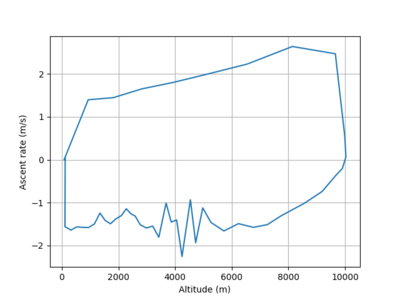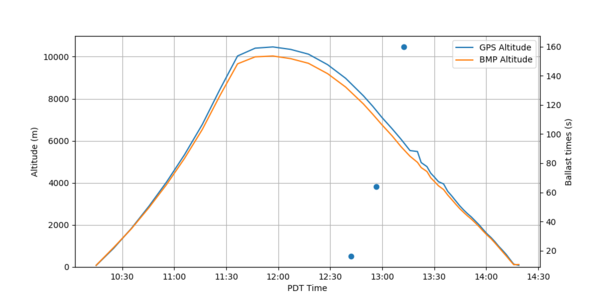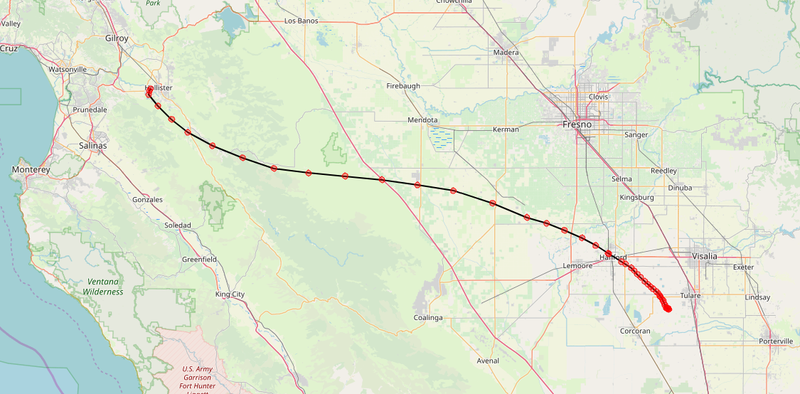Difference between revisions of "SSI-93"
m |
|||
| (6 intermediate revisions by the same user not shown) | |||
| Line 6: | Line 6: | ||
| launch site = Brigantino Park, Hollister, CA | | launch site = Brigantino Park, Hollister, CA | ||
| launch coordinates = 36.849, -121.433 | | launch coordinates = 36.849, -121.433 | ||
| − | | flight duration = 4h: | + | | flight duration = 4h:04m |
| − | | flight length = | + | | flight length = 202 km |
| flight profile = Folded zero pressure w/ ballast control | | flight profile = Folded zero pressure w/ ballast control | ||
| − | | landing time = October 27, 2019, 14: | + | | landing time = October 27, 2019, 14:18 PDT |
| − | | landing site= | + | | landing site=9 km SW of Tulare, Tulare County, CA |
| − | | landing coordinates = 36. | + | | landing coordinates = 36.164, -119.431 |
| last = 92 | | last = 92 | ||
| next = 97 | | next = 97 | ||
}} | }} | ||
| − | + | '''SSI-93''' (project designation '''CY-7''') was the seventh launch of [[Cycloon|Project Cycloon]] on October 26, 2019. It was the zero pressure balloon equipped with altitude control (ballast mechanism), and launched alongside two other zero-pressure balloons at Onboarding. It was the first balloon in the folded topology as a result of a notably eventful filling, and consequently also experienced a noteable post-landing. | |
==Project context== | ==Project context== | ||
| + | The launch plan at the beginning of the quarter had called for a fully controlled ZPB flight coincident with onboarding on '''October 26, 2019'''. However, the unavailability of a vent mechanism and the surprising endurance of [[SSI-92]] motivated the decision to do a long-endurance ballast-controlled ZPB instead. The analysis of data from that previous flight had suggested a thermal difference of 10% during the day; given this, it seemed possible to aim for a multi-day flight with a reasonable amount of ballast. Briefly, on October 18, a floater was considered as the forecast appeared to show winds going towards the ocean, but this was temporary. The primary upgrades, in addition to the vent mechanism, were a heating mechanism and a GPS reset mechanism, lessons learned from the last flight. | ||
| + | Construction of the payload was a streamlined process by this time. Avionics were produced in an October 15 worksession; on October 18 a large number of balloons were manufactured for Onboarding; and on October 20, the payload was integrated, marking launch readiness a week ahead of time. The integration of the payload was tricky, as no top piece was suitable for the legacy ballast piece, and furthermore thermal insulation was a concern. Therefore the bottom half of the polyethylene enclosure was placed inside the styrofoam enclosure. | ||
==Configuration== | ==Configuration== | ||
| + | '''Balloon''': 0.8 mil polyethylene tubing, folded topology, width 2.5 m, length 10 m, volume unknown. Total mass 1 kg with fill tube (PVC of length approximately 12 inches and diameter 1/2 inch). | ||
| + | |||
| + | '''Avionics''': TinyGPS, Teensy 3.2, BMP 280 transmitting at adjustable intervals over Rockblock. SPOT Trace. Ballast control; nichrome cutdown; GPS power reset MOSFET. | ||
| + | |||
| + | '''Power''': 12 L91 lithium AA batteries. 3 L91 lithium AA batteries on resistive heater and cutdown. | ||
| + | |||
| + | '''Ballast''': Legacy valbal mechanism with 500 g ballast, theoretically enough for two nightfalls. | ||
| + | |||
| + | '''Payload''': Half valbal-style polycarbonate cylinder within styrofoam enclosure. Mass 1.25 kg including ballast. | ||
| + | |||
| + | '''Mass budget''': 2.26 kg total. | ||
==Flight synopsis== | ==Flight synopsis== | ||
| + | |||
| + | [[File:Ssi93rates.png|400px|thumb|right|Ascent rates against altitude]] | ||
| + | |||
| + | [[File:ssi93profile.png|600px|thumb|right|Flight profile]] | ||
| + | |||
| + | '''October 26 953 PDT:''' Balloon released after an attempted titration to 0.5 kg of free lift. Moderate winds made this difficult. However, within a few dozen seconds of release the balloon began to descend, and was caught barely within the southwestern boundaries of Brigantino park. A large leak at the top seal was discovered, motivating the decision to fold the envelope over. The balloon was re-filled and observed for 10 minutes for second release. | ||
| + | |||
| + | '''October 26 1014 PDT:''' Balloon released at approximate 1.5 m/s ascent with initial motion to the southwest. | ||
| + | |||
| + | '''October 26 1126 PDT:''' Balloon reached 8438 m at an ascent rate of 2.5 m/s over (36.636, -121.0770), heading southeast over the Diablo range. | ||
| + | |||
| + | '''October 26 1136 PDT:''' Balloon reported an altitude of 10034 m. In post-analysis, it is clear that this transmission marked the beginning of a second phase of the flight, during which the balloon smoothly decelerated into a terminal descent. The cause and nature of this transition remains completely unknown. | ||
| + | |||
| + | '''October 26 1156 PDT:''' A maximum altitude of 10464 m was reported. At the time it was believed that the balloon had equilibrated. This was not a surprise, since the folded topology would have had a much smaller maximum volume, but was still a concerning altitude. | ||
| + | |||
| + | '''October 26 1228 PDT:''' At the 9619 m, the balloon was clearly descending at 1 m/s and clearly had not equilibrated. | ||
| + | |||
| + | '''October 26 1242 PDT:''' A ballast command of 16 seconds was sent in hopes of reestablishing equilibrium. By this time the balloon was at 8.5 km descending at approximate 1 m/s, and the ballast command had no effect. | ||
| + | |||
| + | '''October 26 1256 PDT:''' A ballast command of 64 seconds was sent in a last ditch effort. By this time the balloon was at 7.5 km descending at 1.5 m/s, a rate which it would maintain until landing. | ||
| + | |||
| + | '''October 26 1312 PDT:''' Although equilibrium and endurance was clearly out of the question now, it was noted that none of the ballast commands had any effect whatsoever, calling into question its operation. To verify this, a 100 second command was sent, which finally did evoke a temporary but insignificant perturbation. At this point the balloon was just below 6 km and was approaching its final landing location. | ||
| + | |||
| + | '''October 26 1418 PDT:''' The balloon reached ground level at its landing location. However, this was only apparent in retrospect, as for the next thirty minutes, the balloon appeared to rise over 50 m and fall again twice, and moved approximately one km to the southeast. It is likely that due to the folded topology and mostly inflated envelope, the balloon was blown around substantially by the wind. | ||
| + | |||
| + | '''October 26 1434 PDT:''' The balloon appears to comes to rest at ground level near (36.154, -119.425), yet its coordinates continued to fluctuate. | ||
| + | |||
| + | '''October 26 1443 PDT:''' The BMP malfunctioned and began to report erroneous data for unknown reasons. In conjunction with the strange motions, it is possible the balloon was picked up at this point. | ||
| + | |||
| + | '''October 26 1510 PDT:''' After a 18 minute break in comms, the payload suddenly moved to (36.167, -119.384). It remained in this general vicinity for the next two hours, although coordinates continued to fluctuate and comms intervals continued to be longer than expected. | ||
| + | |||
| + | '''October 26 1713 PDT:''' RockBlock reported a final coordinate of (36.165, -119.389). | ||
| + | |||
| + | In the ensuing hours, SPOT messages reported movement to the east side of Tulare highly consistent with a motor vehicle. The payload appeared to have been moved to two facilities that evening, and again the following morning. The last ping was at October 27 946 PDT from (36.18316,-119.33084), a gas station. | ||
| + | [[File:Ssi93traj.png|800px|thumb|center|Flight trajectory]] | ||
{{balloon-footer}} | {{balloon-footer}} | ||
[[Category: High Altitude Balloons]][[Category: Balloon Launches]] | [[Category: High Altitude Balloons]][[Category: Balloon Launches]] | ||
Latest revision as of 22:14, 7 December 2019
| SSI-93 | ||||
|---|---|---|---|---|
| Designations | CY-7 | |||
| Launch date | October 26, 2019, 10:14 PDT | |||
| Launch site | Brigantino Park, Hollister, CA | |||
| Launch coordinates | 36.849, -121.433 | |||
| Flight duration | 4h:04m | |||
| Flight length | 202 km | |||
| Flight profile | Folded zero pressure w/ ballast control | |||
| Landing time | October 27, 2019, 14:18 PDT | |||
| Landing site | 9 km SW of Tulare, Tulare County, CA | |||
| Landing coordinates | 36.164, -119.431 | |||
| ||||
SSI-93 (project designation CY-7) was the seventh launch of Project Cycloon on October 26, 2019. It was the zero pressure balloon equipped with altitude control (ballast mechanism), and launched alongside two other zero-pressure balloons at Onboarding. It was the first balloon in the folded topology as a result of a notably eventful filling, and consequently also experienced a noteable post-landing.
Project context
The launch plan at the beginning of the quarter had called for a fully controlled ZPB flight coincident with onboarding on October 26, 2019. However, the unavailability of a vent mechanism and the surprising endurance of SSI-92 motivated the decision to do a long-endurance ballast-controlled ZPB instead. The analysis of data from that previous flight had suggested a thermal difference of 10% during the day; given this, it seemed possible to aim for a multi-day flight with a reasonable amount of ballast. Briefly, on October 18, a floater was considered as the forecast appeared to show winds going towards the ocean, but this was temporary. The primary upgrades, in addition to the vent mechanism, were a heating mechanism and a GPS reset mechanism, lessons learned from the last flight.
Construction of the payload was a streamlined process by this time. Avionics were produced in an October 15 worksession; on October 18 a large number of balloons were manufactured for Onboarding; and on October 20, the payload was integrated, marking launch readiness a week ahead of time. The integration of the payload was tricky, as no top piece was suitable for the legacy ballast piece, and furthermore thermal insulation was a concern. Therefore the bottom half of the polyethylene enclosure was placed inside the styrofoam enclosure.
Configuration
Balloon: 0.8 mil polyethylene tubing, folded topology, width 2.5 m, length 10 m, volume unknown. Total mass 1 kg with fill tube (PVC of length approximately 12 inches and diameter 1/2 inch).
Avionics: TinyGPS, Teensy 3.2, BMP 280 transmitting at adjustable intervals over Rockblock. SPOT Trace. Ballast control; nichrome cutdown; GPS power reset MOSFET.
Power: 12 L91 lithium AA batteries. 3 L91 lithium AA batteries on resistive heater and cutdown.
Ballast: Legacy valbal mechanism with 500 g ballast, theoretically enough for two nightfalls.
Payload: Half valbal-style polycarbonate cylinder within styrofoam enclosure. Mass 1.25 kg including ballast.
Mass budget: 2.26 kg total.
Flight synopsis
October 26 953 PDT: Balloon released after an attempted titration to 0.5 kg of free lift. Moderate winds made this difficult. However, within a few dozen seconds of release the balloon began to descend, and was caught barely within the southwestern boundaries of Brigantino park. A large leak at the top seal was discovered, motivating the decision to fold the envelope over. The balloon was re-filled and observed for 10 minutes for second release.
October 26 1014 PDT: Balloon released at approximate 1.5 m/s ascent with initial motion to the southwest.
October 26 1126 PDT: Balloon reached 8438 m at an ascent rate of 2.5 m/s over (36.636, -121.0770), heading southeast over the Diablo range.
October 26 1136 PDT: Balloon reported an altitude of 10034 m. In post-analysis, it is clear that this transmission marked the beginning of a second phase of the flight, during which the balloon smoothly decelerated into a terminal descent. The cause and nature of this transition remains completely unknown.
October 26 1156 PDT: A maximum altitude of 10464 m was reported. At the time it was believed that the balloon had equilibrated. This was not a surprise, since the folded topology would have had a much smaller maximum volume, but was still a concerning altitude.
October 26 1228 PDT: At the 9619 m, the balloon was clearly descending at 1 m/s and clearly had not equilibrated.
October 26 1242 PDT: A ballast command of 16 seconds was sent in hopes of reestablishing equilibrium. By this time the balloon was at 8.5 km descending at approximate 1 m/s, and the ballast command had no effect.
October 26 1256 PDT: A ballast command of 64 seconds was sent in a last ditch effort. By this time the balloon was at 7.5 km descending at 1.5 m/s, a rate which it would maintain until landing.
October 26 1312 PDT: Although equilibrium and endurance was clearly out of the question now, it was noted that none of the ballast commands had any effect whatsoever, calling into question its operation. To verify this, a 100 second command was sent, which finally did evoke a temporary but insignificant perturbation. At this point the balloon was just below 6 km and was approaching its final landing location.
October 26 1418 PDT: The balloon reached ground level at its landing location. However, this was only apparent in retrospect, as for the next thirty minutes, the balloon appeared to rise over 50 m and fall again twice, and moved approximately one km to the southeast. It is likely that due to the folded topology and mostly inflated envelope, the balloon was blown around substantially by the wind.
October 26 1434 PDT: The balloon appears to comes to rest at ground level near (36.154, -119.425), yet its coordinates continued to fluctuate.
October 26 1443 PDT: The BMP malfunctioned and began to report erroneous data for unknown reasons. In conjunction with the strange motions, it is possible the balloon was picked up at this point.
October 26 1510 PDT: After a 18 minute break in comms, the payload suddenly moved to (36.167, -119.384). It remained in this general vicinity for the next two hours, although coordinates continued to fluctuate and comms intervals continued to be longer than expected.
October 26 1713 PDT: RockBlock reported a final coordinate of (36.165, -119.389).
In the ensuing hours, SPOT messages reported movement to the east side of Tulare highly consistent with a motor vehicle. The payload appeared to have been moved to two facilities that evening, and again the following morning. The last ping was at October 27 946 PDT from (36.18316,-119.33084), a gas station.
| Balloon Launches | |
|---|---|
| 2014-15 | SSI-19 • 20 • 21 • 22 |
| 2015-16 | SSI-23(a) • 24 • 25 • 26 • 27 • 28 • 29 • 30 • 31 • 32 • 33 • 34 • 35 • 36 • 37 • 38 • 39 • 40 • 41 • 42 • 43 |
| 2016-17 | 44 • 45 • 46 • 47 • 48 • 49 • 50 • 51 • 52 |
| 2017-18 | |
| 2018-19 | 83 • 86 • 87 • 90 • 91 |
| 2019-20 | 92 • 93 • 97 |
| V • E | |


